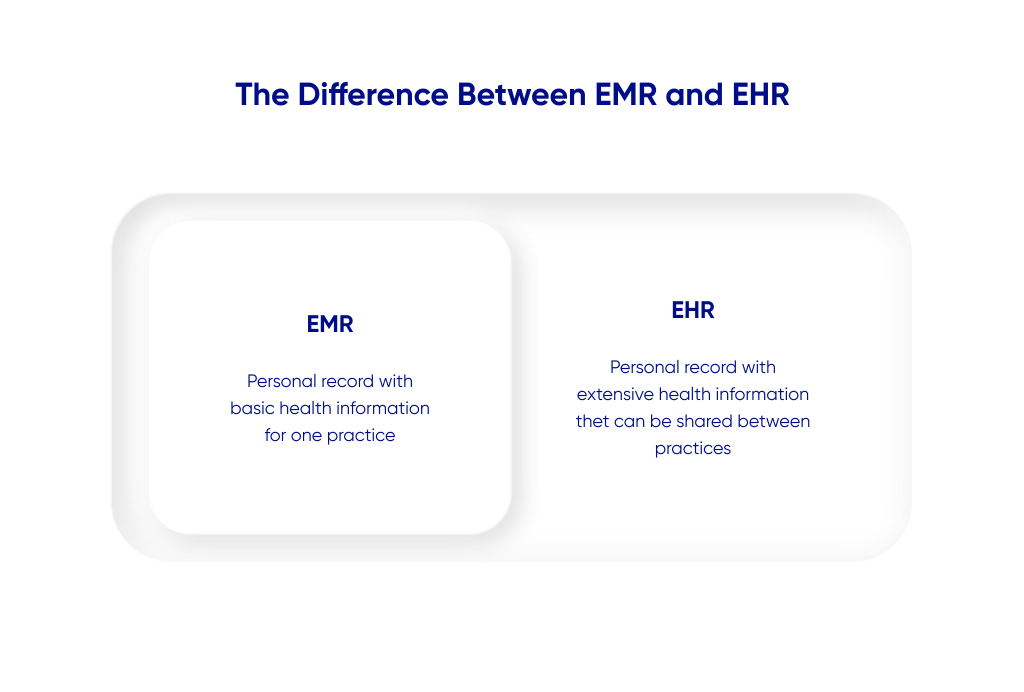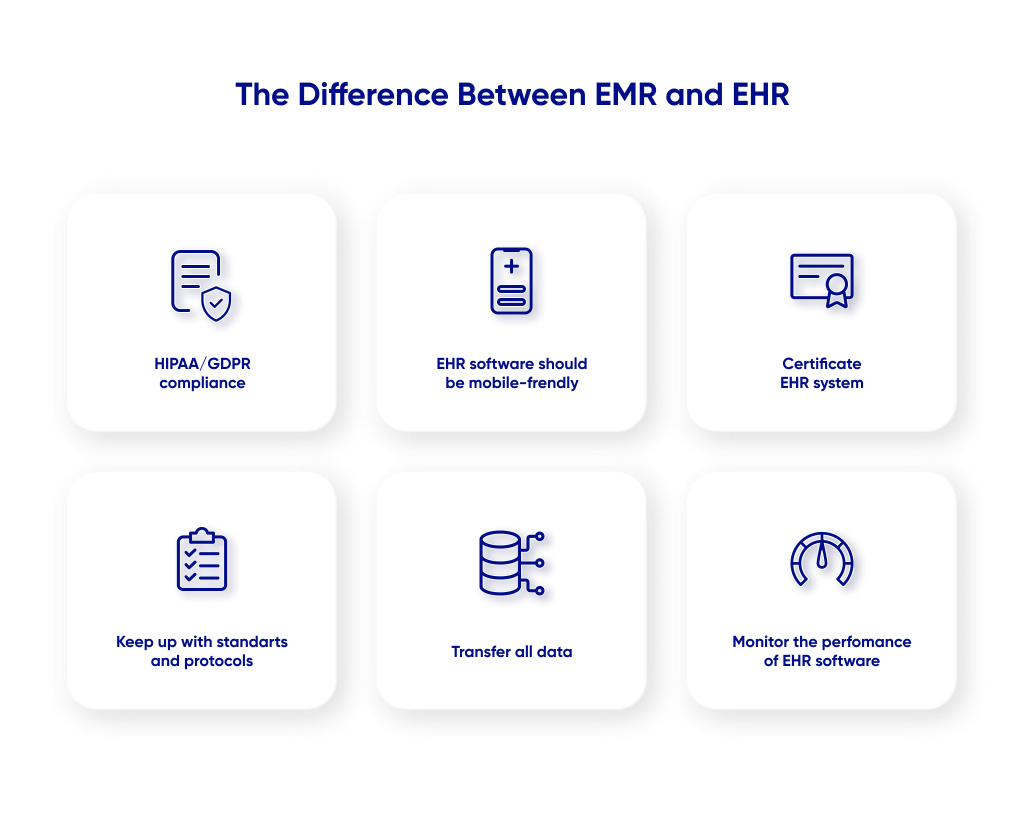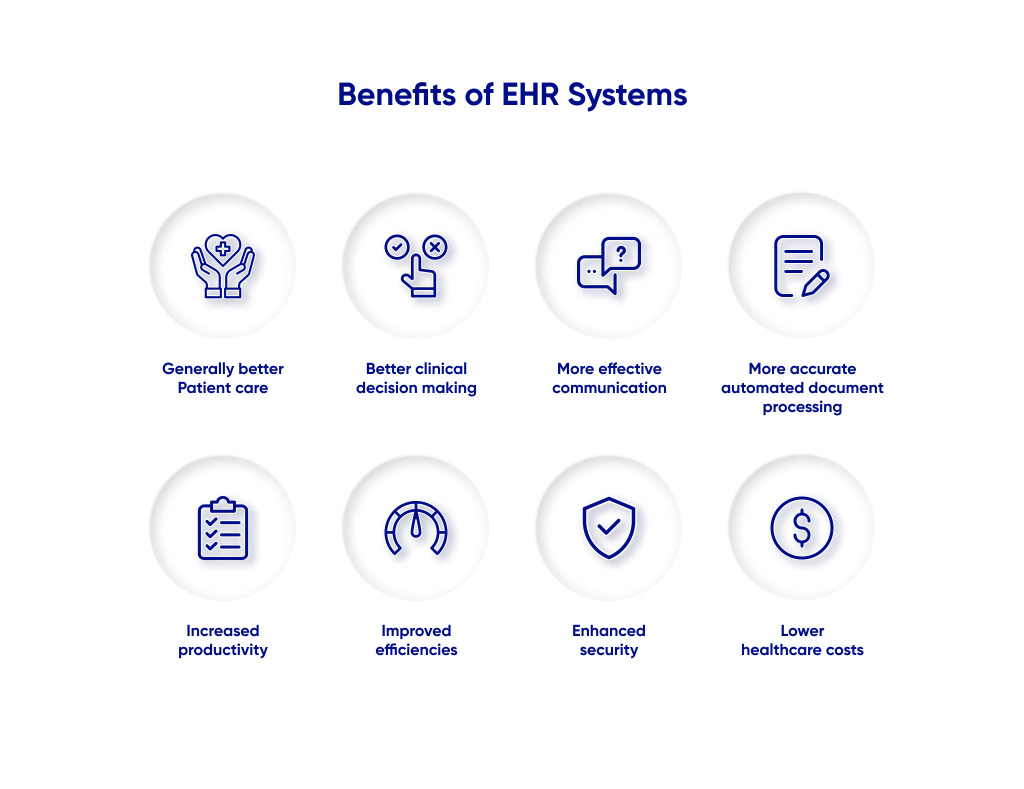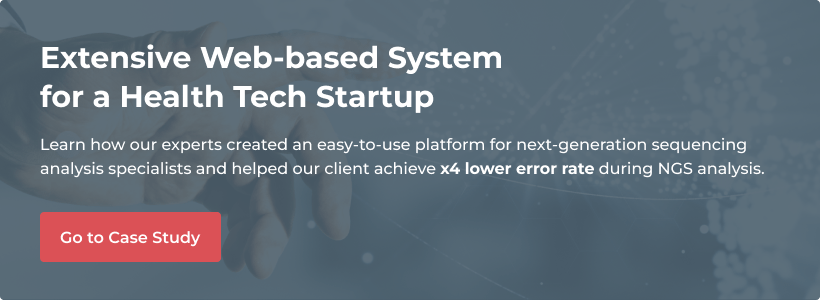IT has repeatedly proven to be of great use to medical professionals. Advanced medical equipment, telehealth, powerful CRMs, and, of course, EHR software development not only simplify the workflow but at the same time enhance the quality of medical services. Modern IT inventions help health workers focus on the main objective of healthcare – to guard people’s health, keep saving our lives, and not waste precious hours handling never-ending copies of different documents.
Today’s market offers hundreds, if not thousands, of healthcare IT developments. And yet, electronic health records (EHR) are presumably the most beneficial and sought-after. And there’s a reason for that. Once the world of state-of-the-art tech inventions began offering health workers a more efficient way to create, store, and manage medical records, there was no turning back to annoying and outdated paper charts. EHR is now being successfully adopted by many healthcare providers worldwide, a trend that is most likely going to remain in the foreseeable future.
Having understood this, Light IT’s team has created this comprehensive EHR guide. You may own a medical facility and hope stand to gain from adopting electronic health recording, or you are a vendor looking to create and monetise your own EHR system, this guide is for you! Keep reading to find out about the EHR development process, technologies, benefits, prices, and more!
Impact of COVID-19 on EHR Adoption
Dealing with pandemics always requires complex countermeasures, including lockdowns, mandatory quarantines, and vaccinations. This is especially true when it comes to such aggressive and mutant illnesses as Covid-19. In response, healthcare workers are using all the help they can get to provide their patients with the highest level of medical care. Additionally, according to the Mayo Clinics Research, EHR adoption plays a major role in Covid-19 prevention and treatment.
For example, it is known that some social groups are at a higher risk of Covid-19 infection and subsequent hospitalisation and death than others. The risk factors include older age, smoking habits, higher BMI, certain health conditions, etc. By storing extensive information about patients, EHR helps doctors determine the high-risk groups of patients, monitor their health carefully, diagnose cases earlier, and minimise the number of fatalities.
Moreover, the information available on EHR allows finding out whether or not an individual tends to develop certain Covid-related comorbidities like myocardial infarction, pulmonary embolism, or cytokine storm, as well as possible vaccine complications.
Having all of the patients’ records at your fingertips is extremely important and helpful for medical professionals. What is more, EHR development gets the job done quickly and efficiently. As such, the global electronic health record market is expected to reach USD 20,318.02 million in 2028, a report by Insight Partners claims.
EHR and EMR. Any difference?
We will start by sorting out the terms, as navigating the topic having a bucketload of abbreviations you are unfamiliar with can be debilitating. `This article is devoted to electronic health records development (EHR). It is a fully digital record containing extensive health information. It may include available medical history (as well as a history of present illnesses), immunisation/vaccination dates, test results, vital signs, allergies, demographic data, medications, lab data, progress notes, etc. EHR may also contain a significant amount of relevant personal information like insurance info or information about family members.

EHR can be transferred between practices, which means that once the record owner changes the doctor, the digital health record follows them, and the authorised specialist gains access to all the essential information at once.
EMR, on the other hand, is short for electronic medical record and consists of patients’ health information and medical history but within a single practice. It is much more limited than the EHR and cannot be instantly transmitted to a different medical facility.

One other major difference between EHR and EMR is the security level. Since the EHR is for providing access to the patient’s health info from different places and for multiple authorised specialists, it must meet a certain security standard that is stricter than the EMR.
| EHR | EMR | |
| Contains patient’s medical records | + | + |
| Available in On-Premise & Cloud Systems | + | + |
| Capable of exchanging relevant data with other systems & providers | + | +/- |
| Billing, Reporting, Scheduling, Analytics | + | + |
| Scalability | - | - |
| Multi-specialty & Multi-location | + | - |
Is EHR software that beneficial?
Now that you are familiar with the EHR concept, we will now look at the benefits of this system.
To keep it clear, we are going to approach the topic from different perspectives: the advantages of EHR software development for business owners, the perks of EHR leveraging for medical settings, and the benefits of electronic health records for patients.
EHR business advantages
If you are assuming that EHR systems development is a brand-new hot trend that appeared in the early 2000s, you’d be wrong. The first attempts to develop an EHR go back to the 1960s. Even then, 60 years ago, when high-speed internet connection was not yet a thing, the global community understood the importance of finding an alternative to paper health charts.
But what exactly turned EHR software into a competitive business area? The great number of benefits!
#1 EHR systems will always be sought-after
With the rapid development of IT and the Internet becoming generally accessible, there’s no turning back to old ways and hand-filled paper charts. Digitalisation is a new norm, and the need for innovative EHR solutions will never be met completely.
Millions of medical facilities worldwide are still to adopt electronic health records; besides, thousands of new settings are built in every year. All this requires a trusted EHR software vendor. Furthermore, technological progress is pushing the industry forward. Ergo, healthcare business owners will always look for the most advanced option on the market.
#2 There is always the need for different types of solutions
The EHR market is not homogenous. Software providers offer different solutions: out-of-the-box and custom, with various types of additional functionality. That way, any kind of healthcare business is able to get software that meets the company’s business needs perfectly. As such, the EHR market will always have room for new players offering unique products (depending on the region, company size, features, etc.)
#3 Different monetisation options
Just like any other type of software, there are various ways of monetising EHR systems. Depending on the vendor’s preferences, this may be one of the existing models, including in-app advertisement, pay-to-pay, free software with paid add-ons (freemium), and others.
EHR perks for medical care providers
If you are somewhat involved in the healthcare industry, you might have already heard how crucial it is to build an EHR system, as it brings many benefits simplifying the daily workflow. But what exactly are those benefits? Here are the seven most important ones.
#1 Improved organisational and operational efficiency
A modern EHR system takes a great deal of pressure off the staff. There is no longer any need to handle dozens of paper copies of all the charts, reports, and bills. Any vital information can be found in the system within seconds. This allows medical professionals to spend less time dealing with paperwork and focus on helping more patients.
Another important point is that EHR enables quick and seamless interaction between facility departments. For example, the doctor instantly receives test results from the lab or X-rays, prescribes certain medications (and the data comes out in the system right away), etc.
#2 Lower risk of malpractice and medical errors
Electronic health records significantly decrease malpractice risks due to the software’s ability to analyse the available information and warn the user about possible adverse reactions, incorrect dosage, and uncontrolled drug interactions.
The patient’s data presented in a clear and structured digital form serves as a backbone for clinicians to determine which areas may require attention and close monitoring, as well as identify patterns for reoccurring mistakes.

#3 Higher level of security for sensitive information
This one is pretty obvious. Digital records cannot get lost or be destroyed as easily as paper charts. Sensitive information is available only to authorised personnel, and there is a bunch of legislative acts that obligate medical facilities to provide extra security measures (including encryption, automated session termination, multi-tier access, digital signatures, etc.). With a compliant EHR, the chances of “something going wrong” in terms of data security are significantly reduced.
#4 Safe, fast and easy data exchange
There will always be the need for smooth, trouble-free information exchange within the practice and between facilities. Even if the patient chooses to never change their doctor, there might appear a necessity for a third-party opinion or a consultation. In such instance, the electronic health record safeguards the security and integrity of the patient’s health information and guarantees smooth immediate access to it for any medical worker chosen by the patient.
#5 Reduced costs
Adopting a modern IT solution is definitely an investment for the healthcare business. Yes, it takes money to adopt an EHR system. However, this software eventually produces a return on investments by lowering non-clinical labour costs.
This includes reducing the transcription costs, fewer expenditures on physical chart storage, simplified coding, and claims management, with overall minimised consumption of resources.
#6 Better doctor-patient interactions
EHR implementation is a vital step in building a patient-centred communication process that will be meaningful and less stressful for both the clinician and the patient. First, medical facilities can employ the technology to create a smooth administrative process that will reduce the stress level for patients. Moreover, leveraging EHRs turns the patient from a clueless silent observer into an active collaborator.
Patients are able to not only communicate with their physicians via electronic messages, but also access their health records and health education tools, track progress, and even read the clinicians’ notes. All these options may seem unnecessary. However, they are something that makes the patients feel in control and stimulates their engagement.
#7 Overall improved patient care
Last but not least, EHR software development and adoption is crucial in boosting the quality of healthcare. Fewer mistakes and misinterpretations, simplified preventive care processes, easy and quick data collection and analysis, more balanced decisions, and many other helpful features really make a difference.
EHR benefits to the patient
We will now talk about the benefits EHR adoption offers patients. In a way, some of them mirror the advantages for clinicians (listed above), as the interests of the patients and the healthcare workers intersect.
#1 Easy instant access to all necessary information
EHR software usually includes a user-friendly patient portal where a user can get all relevant records without the need for additional appointments with the doctor. It is always nice to have an opportunity to double-check the test results, quickly and precisely answer health-related questions from the insurance company, or control your sick child’s treatment.
#2 No unnecessary duplicating tests
When a healthcare setting lacks access to a trustworthy and complete medical record, the patient is often asked to take certain tests multiple times. This may be quite uncomfortable, especially when the test requires some kind of restriction (e.g., fasting) or is expensive (e.g., full-body MRI). Luckily, electronic health records resolve this problem, as all the data are updated instantly and the physician has access to the most recent information at all times.
#3 No annoying paper charts
Anyone who has visited a medical facility that has not yet adopted EHR software knows that paper charts with hundreds of similar questions can be aggravating. The good news is that EHR takes that weight off the patient’s shoulders. All that’s required is to fill in the form once and after that, no more paper charts ever!
Rules and regulations a proper EHR system should meet
Any healthcare business is bound by numerous government-mandated rules, regulations, and legislative acts. Of course, the number of EHR-related laws and the requirements vary from country to country. As such, there’s no such thing as “one type of software fits all.” Any medical care provider must opt for a solution that was designed to specifically meet local healthcare regulations.
For example, on the European Commission website you can find all the relevant national laws that apply to electronic health records in the member states. There is also GDPR compliance that you should not forget about if you’re planning to operate on the European market.
However, when it comes to Healthtech, the United States is the trailblazer that has managed to develop a consistent legislation base and ensure its enforcement. In this section, we will focus on the laws and standards that apply to EHRs in the US.
The HITECH Act of 2009 is arguably the most important health IT-related law. This document has put the whole EHR idea on the map encouraging the healthcare providers in the US to adopt electronic health records.
The Health Insurance Portability and Accountability Act (HIPAA) adopted in 1996 covers several healthtech development aspects, including unified standards for electronic healthcare transactions and national identifiers for providers, as well as health insurance plans and employers. The main goal of the HIPAA is to protect sensitive information and ensure secure ways for its usage and disclosure.
The main purpose of the 21st Century Cures Act is to simplify the exchange of digital healthcare info, prevent information blocking, increase accessibility, and advance interoperability in healthcare. In a nutshell, this means that all individuals and healthcare providers can access and exchange electronic health information freely.
Any healthcare services provider in the US must ensure that its EHR software is fully compliant and meets all legislative requirements. Otherwise, the provider will face severe consequences, including major penalties and even a prison sentence. If you ever require a simple, yet helpful, compliance checklist, check Light IT’s article on this topic.
EHR technologies you should know about
When it comes to the tech stack for EHR software development, there is no one right answer. Every IT company offers a unique set of technologies that they consider the most suitable for healthcare solutions implementation.
There are certain industry trends and some technologies that are more popular than others. For example, Python is currently one of the most widely used languages. It is known as one of the safest (complies with HIPAA) and diverse languages. At that, PHP is often considered dated, inconsistent, and not secure enough.
However, those are just suggestions, and if for some reason you are not willing to use a specific programming language or framework, there is always a way to find an alternative. Just take a look at the list of the most popular technologies applied in the development of electronic records.
| Languages: | Python, Swift, C++, Java, Ruby, Kotlin, JavaScript, C#, PHP |
| Frameworks & libraries: | Django, Angular, React, jQuery, Vue.js, Node.js, Bootstrap, Laravel |
| SDKs: | iOS, Android, Flutter |
| Databases: | MySQL, PostgreSQL, Redis, MongoDB |
| Web server: | Apache, Nginx |
| Messaging: | RabbitMQ, ActiveMQ, Apache Kafka |
| Analytics: | Google Analytics, Amazon EMR |
| Payment gateway: | PayPal, Stripe, Skrill, ACH Payments |
| Utilities: | Celery, Cloudflare, Amazon S3, Elasticsearch |
| Hosting: | AWS, Azure, Vultr, GCP |
Why does Light IT recommend Python for EHR?
Python has established itself not only as one of the most sought-after technologies of 2022, but it is also nearly perfect for healthcare solutions development (specifically EHR systems).
Firstly, Python is in full compliance with the HIPAA medical data safety checklist. Secondly, it is able to provide high performance even on load typical for healthcare facilities.
Another important advantage is using Python for ML models development and implementing EHRs with predictive analytics capabilities. This is how the system is able to determine higher disease risks for certain patients — just by analysing the available information.
The introduction of Data Science and Machine learning into Python healthcare applications also enables quick and effective image analysis that significantly improves accuracy in diagnosis.
We cannot but mention that many modern IT companies that offer health records software development use programming languages other than Python. However, our experience has proven that Python is amongst the most stable and powerful technologies for implementing healthcare solutions.
Top-10 vital features of a modern EHR system
While it is completely normal that EHR solutions have different functionality and are usually customised to the needs of a particular medical facility, there is a set of features that forms the backbone of the future EHR system.
These features are mandatory for the proper functioning of the electronic health record, and should never be overlooked.
#1 Document management & Charting
First things first, the electronic health record development aims to help healthcare providers simplify the workflow and boost patient care quality by offering an easy-to-use and functional digital document management tool. It is the core of any EHR system.
It is essential to ensure the system supports different document formats (including industry-specific ones like DICOM — for CT and MRT images), is well-structured, and has a clear intuitive interface.
Digital charting is equally important as a convenient document management tool. If done right, it eliminates a large amount of redundant paperwork and increases the clinicians’ productivity. Look for comprehensive and customisable chart templates that will fit your practice specifically.
#2 Task management
A modern EHR cannot function without advanced task management capabilities. The system should allow clinicians to easily assign tasks, monitor progress, delegate tasks to other specialists, send reminders, and control completion.
#3 Prescription management
E-prescribing is an extremely important functionality of any EHR system, as it conducts multiple digital processes that streamline and clarify electronic drug prescriptions. While prescribing medications remotely, the physician is able to track and verify the drug’s use and avoid possible drug incompatibility. Moreover, the information about the prescribed medications in the patient’s health record will be updated automatically, saving the clinicians’ time.
#4 Data access control
It is mandatory for an EHR system to employ a multi-tier access policy. It is not only one of the main requirements for HIPAA compliance, but also a handy tool for duty distribution.
The system must contain multiple access levels depending on the user’s status. In other words, a doctor and a nurse should never have access to the same information. While the physician manages all the patient’s data, the nurse should only be able to access basic information.
There are several tools that help ensure the highest level of data access control, including:
- Unique identifier use
- Automated log off/session termination
- Encryption standards support
- Emergency access options
- Multifactor authentification
- Automated blocking of suspicious and/or compromised accounts
- User actions logs (number of consultations, injections, prescriptions, procedures, etc.)
#5 Reporting
An integrated, comprehensive reporting functionality is the easiest way for healthcare workers to get a comprehensive overview of the ongoing processes, measure the results, and estimate efficiency. A valuable system should provide medical professionals with a tool that instantly creates all kinds of reports based on the chosen parameters (e.g., medication, demographics, procedures, etc.)
Keep in mind that the EHR may offer reporting functionality not only for the clinicians but also for the patients. Users will appreciate a simple graphic representation of their progress or medication interaction.
#6 Scheduling and time management
Scheduling functionality safeguards the accessibility of healthcare services. Every patient must be able to schedule an appointment with their physician via digital channels, and doctors must have a simple electronic tool for time management.
One common example of scheduling functionality in the EHR system is an interactive calendar. The doctor gets a clear understanding of the number of appointments for the day, and the patient can easily choose a comfortable date and time for the planned visit. The calendar also ensures flexibility on both the practitioner’s and the patient’s party as there is an opportunity for appointment rescheduling by mutual arrangement.
#7 Patient profile
A comprehensive patient profile is one main instrument the clinician uses to ensure maximum efficiency on a daily basis. As such, the page with the patient’s data should be well-structured and contain all the relevant information the doctor might need, including general information (full name, age, gender, etc.), disease and treatment history, allergies, test results, medications, billing information, etc.
#8 Labs & tests integration
Seamless integration of the EHR with the associated labs guarantees immediate data exchange for faster and more precise decision-making. The test results are sent directly to the app, and the information is updated automatically. The final step of the process is notifying both the physician and the patient.
Note that this principle applies not only to labs but to all external vendors providing digital tests for the patient.
#9 Patient portal
As mandated by law, an individual must have free access to their health information, while healthcare service providers must not block the patient from accessing that information in any way. A perfect solution that enhances health info accessibility is a simple patient portal. This is the part of EHR that is available not to the physicians, but to the patients themselves. Individuals can get an overview of the treatment process, schedule an appointment, view the prescribed medications, generate relevant reports, and access helpful educational resources.
The number of features included in the patient portal is extensive, and it is up to the provider which functionality to offer the customer.
#10 Invoicing
Any medical facility has to deal with invoices, denials, insurance companies, unpaid claims, and other not-so-pleasant elements of administrative work. An EHR system should simplify that process by automatically generating invoices after each patient’s appointment, complying and sending claims to the insurance providers, and handling system exclusions.
What are the most important stages in EHR development?
Unlike other types of software development where the cycle is pretty simple (strategy — planning — design — development — testing — support), the development of EHR system is far more complex and requires cooperation from the business owner and the dev team on all stages.
Evaluate organisational readiness
Many business owners forget about this step and end up paying double the price. Everybody in the healthcare business knows how important and beneficial electronic health records are, but few tend to think about the consequences of the implementation. Is staff willing to accept a new EHR system? Do your employees have the skills to work with the EHR? Are there any cases of bad experiences with some EHR providers? Is the IT department functioning properly? These are only a few questions a business owner should find answers to before the development process starts.
Find the flaws in the existing workflow
So many entrepreneurs are willing to spend bank on “improving the processes” without actually knowing which processes to improve. To avoid that scenario, analyse the existing workflow and determine the weakest areas.
The best way to do this is to simulate a patient’s journey and a clinicians’ shifts step-by-step. Create a list of the current problems/flaws, and think about the ways you would like the EHR system to transform the workflow
Build a roadmap
A roadmap is the easiest way to create a coherent strategy, coordinate team efforts, and improve communication. Your goal at this stage is to determine the objective, and the tasks for every team member as the EHR implementation will require specific actions from everyone involved in the process.
Building a roadmap is especially beneficial if you plan to divide the development into multiple stages (e.g., building an MVP first and adding a variety of extra features later). Using a roadmap, you can visualise your idea and come up with a viable action plan.
Select a vendor
Choosing a trustworthy EHR software development provider is much more complicated than opting for the most popular name on the market. There are several things an entrepreneur should take into consideration.
- Is the system compliant?
- Will it be accessible on any electronic device?
- Is the EHR certified?
- Will it support all the necessary integrations?
- What kind of hosting do you prefer?
Do not go for the first available provider you will find. Take time to evaluate all your options, interview several potential contractors, compare quotes and the included services, and then make a balanced decision.
Adapt and prepare
While the development team gives your future EHR a solid digital incarnation, you, as the business owner, have a preparation stage to go through. The future successful adoption fully depends on your attention to detail at this stage.
Check if your IT system is ready for the future load. Make sure the security system is up to par. Plan future staff training. Establish a fail-safe communication channel with the vendor. Instruct employees about the emergency procedure. All this will ensure a smooth launch once the EHR development is over.
Test and evaluate
One of the most common mistakes at this stage is looking for immediate improvements. In reality, the CEO should be ready for a visible decline in the staff’s productivity that may last about six months.
It is important to give your employees some time to familiarise themselves with the new platform and not expect an efficiency boost right away. Launch staff/patient surveys on a regular basis and carefully analyse the feedback. Do not ignore any negative comments regarding EHR, as improving the processes will be possible only if the staff has no problem using all of the platform’s functionality.
Do not forget about metrics. Define a couple of the most important markers (e.g., average appointment time or a number of transactions) and compare the results before and after the EHR adoption.
Improve and support
The last stage isn’t the most challenging but is never-ending (at least until you decide to choose another vendor).
Use all the available feedback to make your EHR more user-friendly and easier to use, as the more intuitive the solution is, the more efficient it will be. Also, always keep up with industry trends and legislation updates. Technology is transforming the modern healthcare business faster than you think, and it is vital to be ahead of the pack to be the first to reap the generous benefits of technological progress.
What about the development cost?
An EHR may be helpful, but is it affordable? Luckily, the modern software development market offers multiple options for budget-friendly EHR implementation. We will briefly review all of them.
Out-of-the-box EHR
By far the cheapest option. Ready-made solutions always cost less than customised systems. The cost for this kind of system may vary from USD 15K to USD 70K depending on functionality and the chosen provider.
Although these numbers are significantly lower than the prices for custom EHR implementation, we do not recommend opting for this kind of solution. Limited functionality, possible compliance issues, unregular updates, uncomfortable UI/UX, and many other drawbacks decreasing staff’s efficiency may appear in the out-of-the-box EHR over time.
Employ a local software development company
This option may be highly beneficial in terms of finances, but the final price of the EHR development will depend on where your business is located. Software development services in the US, Canada, or the EU cost more than in Eastern Europe or Asia. Consequently, vendors will ask for a higher hourly or monthly rate.
For example, the hourly rate of a software engineer in Germany is 2,3 times higher than for a specialist of the same level in Ukraine.
Outsource
This is one of the most popular options among healthcare business owners. Outsourcing offers a great quality/price ratio while not taking the control away from the customer. The hourly/monthly rate for a modern EHR will depend on two main factors:
- Remote team location
- EHR complexity
As for the best region to outsource IT services to, Eastern Europe takes away the garland. The rates there are lower than in Western Europe, the US, or Australia, developers and managers have no problems with English, and most of the vendors already have an impressive portfolio.
The complexity of the solution is another factor that impacts the budget heavily. Depending on the desired features and the volume of customisation, the cost for EHR implementation might rise exponentially.
Moreover, the business owner should not forget that the EHR should be available for all devices. It is therefore mandatory to include at least three versions of the app in the budget: web application, iOS & Android apps. The minimal cost for each of those applications starts from USD 40K-50K and may reach up to USD 300K depending on the chosen vendor and software complexity.
Modern EHR examples
Just like any other business niche, health IT has its own trusted brands that are well-known worldwide. Here are the most popular EHR vendors that dominate the market in 2023.
#1 Epic
Epic is the most popular EHR in North America, covering 34,1% of the US national market. It offers not only basic automation features like scheduling, filtering, or a financial module, but also some advanced functionality like predictive analysis, telemedicine, and voice recognition.
#2 Cerner
Cerner is Epic’s main competitor. In terms of functionality, these EHR vendors are fairly equal. However, Cerner is more prevalent among ambulatory care and smaller practices, while Epic is the first choice for big enterprises. Besides, Cerner offers its customers AI-enabled workflows and 24/7 live support.
#3 Meditech
The “bronze medal in the EHR Olympics” goes to Meditech – a software vendor that managed to occupy 14.7% of the US market. One of the greatest assets of Meditech is its lower cost compared to more popular vendors. Just like Cerner, Meditech is marketed towards smaller medical facilities. The main advantages of the system compared to its competitors are user-friendliness and many customisation options for higher efficiency.
Final words
The Light IT team hopes that this article has helped you better understand the complex but important process of EHR software development. If you have any questions that still remain unanswered, do not hesitate to contact us immediately. Light IT experts will be happy to assist you in the journey to your perfect EHR system!





